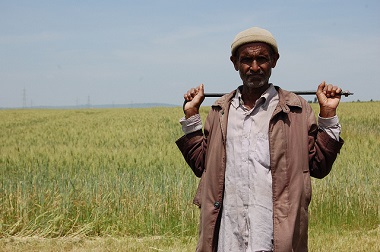The following post was originally published on the Agrilinks site.
There is a persistent gap in developing countries between potential and actual yields for many crops. There are several reasons why actual yields lag potential yields, including a lack of information, appropriate finance, access to inputs, and reliable market opportunities. If the yield gap could be reduced or eliminated, it would have profound effects on smallholder incomes and food security. Not surprisingly, a goal of Feed the Future is to improve productivity and reduce the yield gap by understanding what factors constrain the adoption of improved varieties.
To attempt to help farmers improve yields, Ethiopia’s government created the Agricultural Transformation Agency (ATA), which is working to improve yields for cereals and other agricultural products. As part of its support to the ATA, the International Food Policy Research Institute helped design a randomized control trial to test how a “package” intervention helped improve wheat yields. To begin the experiment, benchmark farmers were selected in each kebele (neighborhood, similar to a ward) to receive the intervention package. The premise was that as other farmers noticed techniques or better looking crops in benchmark farmers’ fields, they would adopt those techniques and/or inputs.
Free, cheap, or simply available: what makes the difference?
Randomization took place within each kebele, with five farmers among 14 selected to receive the Wheat Initiative intervention package. The package included four major components: inputs (including quality improved seeds and fertilizers), best agronomic practices, access to finance, and access to better market linkages. The benchmark farmer selection included two model farmers, two non-model farmers, and one female farmer in each kebele. Benchmark farmers received agronomic training, improved seed on credit, and 50kg of urea fertilizer and 25kg of gypsum for free. The idea was to provide enough seed and fertilizer to plant a half-hectare appropriately. Note that other farmers in the sample were not precluded from buying aspects of the package (such as seeds and fertilizer) that were available on the market. However, they did not receive the training in agronomic practices, nor the improved seed or reduced price urea that benchmark farmers received. As a consequence, we measured the impacts of receiving training and elements of the wheat package either for free or at a subsidized rate relative to a situation in which new inputs simply become available.
We measured wheat yields in three different ways. First, we conducted crop cuts on small portions of fields of treatment and control group farmers just before harvest, and weighed the produce relative to the area of the crop cut. Second, we asked farmers to estimate total wheat production on the main plot, and enumerators walked around field with GPS units to measure area. Finally, we asked farmers to estimate both production and sown area.
Measuring matters
Our findings were illuminating, both about farmer self-reports of production and area, and about the impacts of the wheat package. We found that farmer reports about production were fairly accurate: among farmers who participated in the crop cut, the correlation between their production report and our projection (based on the estimated yield for the crop cut multiplied by area) was reasonably high, and impact results were similar for the crop cuts and the production self-reports. However, there was a substantial difference between areas estimated by GPS and by farmers. We found that farmers tend to “round up” their land area; if they plant 0.37 hectares, for example, they round it up to 0.5 hectares.
Using the first and second methods of measurement, we found that the wheat package improved wheat yields by between 12 and 13 percentage points. Had we relied solely on self-reports, however, we would have found no impacts—our estimate was four percentage points, but was not significantly different from zero.
The impacts depend on the technology
Through the questionnaire, we were also able to measure which parts of the wheat package appeared to lead to impacts and which parts did not. We found that almost all farmers, both those who received and those who did not receive the intervention package, were at least aware of recommendations about planting practices (row planting, more disperse seed). While farmers in the treatment group were much more likely to have actually tried row planting, many farmers did not plan to use it the following year due to its labor intensity relative to traditional methods. In addition, implementation was not perfect– some farmers never received some components of the package, while some control group farmers received some portions of the package (for example, 17 percent of control group farmers received free urea). As a result, the increase in yields we observed was lower than it would have been if more treatment farmers would have received all the components and if control farmers had not received some free inputs.
Consequently, our estimates are something of a lower bound for the impacts of receipt of the wheat package on yields among benchmark farmers. However, our research demonstrates that the Wheat Initiative intervention package can potentially increase yields, and provides evidence of opportunities to further innovate; for example, educating farmers about less labor intensive methods of row planting could help increase its adoption.







